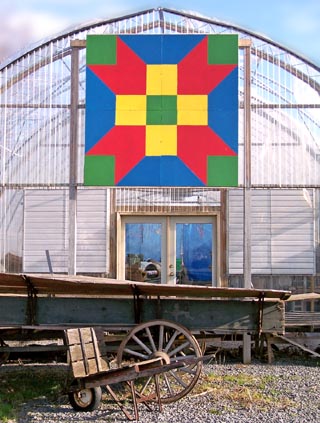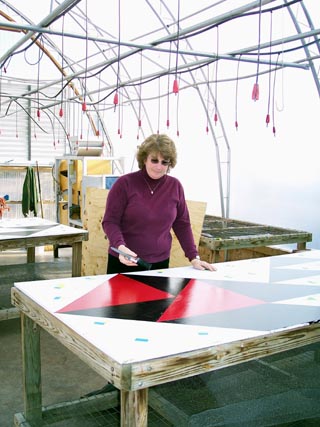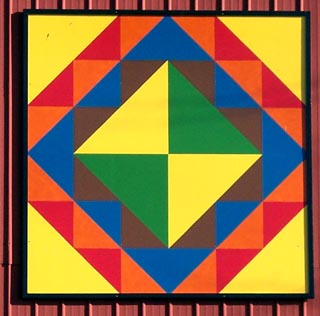
8 x 8 ft. squares grace area structures When people think of a quilt, what typically springs to mind is a cozy piece of fabric made up of smaller sections that comes in a wide array of colors and designs that is meant to warm a lap on a cold winter’s night. When Lora Partyka, of Kendall, thinks of quilts, she now thinks of those that grace the walls of barns in the Kendall area. “I saw a quilting magazine that showed a project from Iowa where they were painting quilt blocks on the sides of barns,” Partyka said. “I have a love of both barns and quilting and thought it was a neat project for Kendall. I gathered a group of ladies and discussed getting some quilt blocks on the sides of barns in this area.” Barn quilts are large, colorful wooden blocks that are designed, painted, then mounted on the side of barns. Partyka said that the blocks need to be painted on special wood and they have been able to get the wood - at an “extremely good price” - from Stockham Lumber in Holley. “We’ve had a lot of excitement building around the project,” Partyka said. “What we do for people in the area who want one is we give them quilt books to look through and they typically choose a design that has some meaning to them.” Partyka has a block called “The Farmer’s Daughter” on her greenhouse. “The block originated in the 1800s when a girl married and left her family. I’m a farmer’s daughter, so it was fitting,” she said. Kludt Farms in Kendall has a block on one of their barns called Corn and Beans. “The block shows dirt, beans and the sun and is a good representation of what their livelihood is,” Partyka said. Partyka has help in designing the blocks from long-time quilter friend Kathy deMarco. “She takes the pattern that someone chooses, designs it on wood, lets them pick the colors and then enlarges it to be eight feet by eight feet.” The women involved in the project are hoping that the blocks will not be duplicated on the barns in the area. “We want to keep the project unique and will encourage people to pick something that hasn’t been chosen,” she said. “When choosing the block most people are picking a design that relates to their family history or to something that means something to them personally.” Partyka said individuals who want to see their barn wall graced with a block pays for the materials for their own block and mounts it themselves. “Eventually we’d like to get signs put up so visitors to the area can take a driving tour of the blocks and see what they mean,” Partyka said. “We’d like to coordinate it, along with a flier in conjunction with the farmer’s market.” Designing the large blocks, deMarco said, is simply a matter of breaking the design down into eights and measuring in terms of feet rather than inches. A long-time quilter, deMarco said transferring the patterns from material to wood is a simple matter. “Some are more difficult than others but I’ve been quilting for a long time so it’s all a matter of measurements and proportions.” The design that will be on the barn at the deMarco’s will be one of the more difficult that she has designed. “I’m going to do a Carpenter’s Wheel and that is made up of all diamond shapes,” she said. “My husband is a carpenter so the block will go up on the wall in his shop.” When it comes to the actual design, deMarco said she sketches it on a small block of wood with different colors - mostly primary colors - then when she transfers the design to the large block of wood she marks it with sticky notes to denote what colors go where. “This has been an interesting project and it’s a thrill to see the finished blocks and the way the color palettes look when they are enlarged,” she said. Partyka said she has been having a great time with the project so far and can’t wait to see how far it progresses throughout the town. Examples of barn quilts from Iowa can be viewed at www.barnquilts.com. January 7, 2007 |


